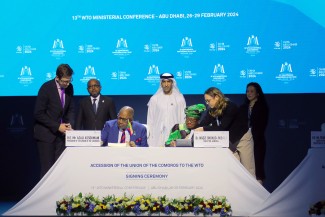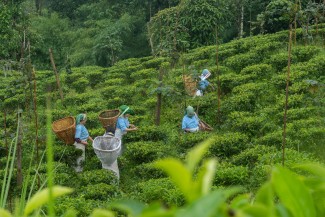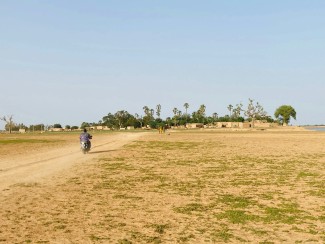Driving through Cambodia’s country-side, one can’t help but notice the endless rice paddies that appear to extend in every direction. This should come as no surprise given that, for millennia, rice has been a central part of the country’s diet, and its most important crop. One that to this day occupies up to three quarters of the country’s cultivated land.
Rice farming is a time-consuming affair. First, the paddies must be ploughed before rice seedlings can be planted by hand. When the time comes, pesticides and fertilizers are applied with sprayers connected to plastic jugs farmers wear on their backs. During harvest, the rice is cut by hand or, in the case of larger paddies, by machines. Often large groups of neighbours and relatives join hands, moving from one family's plot to the next. Rice grains are then threshed, often by hand, before it is dried, sometimes laid out on the road. Finally, the rice is transported to market for sale, or consumed by farmers themselves.
In most cases, rice is cultivated through traditional farming practices by over 80 percent of the country’s farmers on farms of less than two hectares. Across the entire value chain—from production, to processing through to marketing—the sector is estimated to employ approximately 3 million people, making it the largest employment sector of the Cambodian economy.
LOST OPPORTUNITY
Until recently, most of Cambodia’s rice was being exported in its raw form to neighbouring countries as rice millers struggled to meet stringent export requirements. This represented a significant loss of value added for the Cambodian economy, and paddy rice prices in Cambodia were 35-40 percent lower than neighbouring countries.
By investing in modern rice milling facilities, Cambodia could produce higher quality milled rice for growing international markets and gain international recognition for its milled rice standard.
At the same time, by processing the rice in country, Cambodia could generate jobs and income, as well as take advantage of spin-off activities such as cooking oil production, aquaculture and animal husbandry.
INVESTING IN RICE
In 2011, the Cambodian government identified export diversification as critical to the country’s economic development, and set a target to turn the country into a major rice exporting country.
The Enhanced Integrated Framework (EIF), housed within the World Trade Organization (WTO), works in partnership with the governments of 47 Least Developed Countries (LDCs), and played a key role in enabling Cambodia to become the 158th member of the WTO in 2004.
Part of the EIF’s support since has included working with the government to identify barriers to trade and export in the rice sector, aimed at strengthening the country’s competitiveness.
Over a period of 10 years, the EIF—in collaboration with the International Finance Corporation and the European Union—worked with millers to help them grow from family-owned and managed businesses into professionally managed outfits that, by using more modern equipment and improving their processing standards, could meet stringent export requirements.
The EIF facilitated the participation of 328 exporters in nine trade missions and food fairs in Europe, Hong Kong, Singapore, Thailand and the USA. These trade mission and fairs exposed exporters to new markets, and allowed them to gain a better understanding of the demands of importing countries.
The project also provided farmers access to improved rice seeds and farm management training to increase their yields and the quality of paddy rice.
WORLD RENOWNED RICE
With the EIF's support, Cambodia's commitment to helping lift people out of poverty has materialized into tangible benefits for the most vulnerable, including rice farmers.
Cambodian rice farmers, millers and exporters have been able to improve the competitiveness of the country’s milled rice and diversify to new markets, leading to a threefold increase in exports between 2011 and 2016, which has translated into job creation and higher incomes.
Over 50 percent of Cambodian rice exports are of fragrant rice, a higher-value produce, and as a result Cambodia won the World’s Best Rice Award three years in a row, in 2012, 2013, and 2014.
If you would like to reuse any material published here, please let us know by sending an email to EIF Communications: eifcommunications@wto.org.



